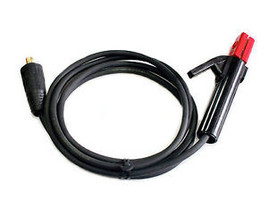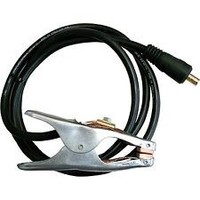Welding cables are electrical cables that transport the current from the welding machine to the workpiece. They consist of an insulated copper cable surrounded by a resistant sheath. This sheath protects the cable from mechanical influences and from wear caused by heat and welding spatter.
Welding cables are available in various lengths and cross-sections, depending on the requirements of the welding process.
The welding cable is an important component of every welding system. It is responsible for conducting the welding current to the welding torch and must be able to do so without overheating or arcing. The welding cable is also important for safety. It must be able to withstand the heat and sparks of the welding process and protect the welder from electric shock.
There are a variety of welding cables available, and which type of cable is best for a particular application depends on the type of welding process, the materials being welded and the environment in which the welding is being performed.
Here are some of the most common types of welding cables:
- Stick welding cables: stick welding cables are used for stick welding, a type of arc welding that uses a consumable electrode. Stick welding cables usually consist of a copper conductor surrounded by a PVC sheath.
- MIG welding cables: MIG welding cables are used for MIG welding, a type of arc welding in which a wire electrode is used. MIG welding cables usually consist of a copper conductor surrounded by a rubber sheath.
- TIG welding cables: TIG welding cables are used for TIG welding, a type of arc welding in which a tungsten electrode is used. TIG welding cables usually consist of a copper conductor surrounded by a PVC sheath.
High quality welding cables are made of durable materials that can withstand the heat, abrasion and physical stresses often encountered in welding applications. The cables are typically made of copper, which is known for its excellent electrical conductivity, flexibility and corrosion resistance. Copper conductors allow for optimal current flow, minimize energy loss and ensure consistent welding performance.
The insulation surrounding the copper conductors plays a critical role in protecting the cables and maintaining their electrical integrity. Welding cables are insulated with materials designed to withstand the heat generated during welding and insulate against electrical shock. Common insulating materials include EPDM (ethylene propylene diene monomer) or neoprene, which offer excellent resistance to heat, oils, chemicals and abrasion.
Welding cables are available in different sizes, commonly referred to as gauge or AWG (American Wire Gauge). The cable size is selected based on the current carrying capacity required, with larger gauge sizes being able to handle higher currents. Choosing the right wire size is important to ensure safe and efficient current transfer in the welding process.
Flexibility is another important characteristic of welding cables. The cables must be flexible enough to allow the welding equipment to be moved and positioned easily, even in confined spaces. The flexibility of cables allows welders to work comfortably and efficiently, reducing fatigue and improving overall productivity.
Welding cables are often available in different lengths to suit different welding configurations and working environments. The right cable length ensures optimal reach and accessibility, allowing welders to work on different projects without restrictions.
Proper maintenance and care of welding cables is essential for their longevity and performance. Regular inspection for damage such as cuts, cracks or frayed insulation is crucial to identify potential safety hazards. Cleanliness is also important as dirt, grease or other contaminants can affect the insulation and electrical conductivity of cables.
To summarize, welding cables are critical components in welding systems as they provide the electrical connection between the power source and the welding equipment. With their durable construction, excellent electrical conductivity and resistance to heat and abrasion, welding cables ensure efficient power transmission and reliable welding performance. By choosing high quality cables, maintaining them properly and using the appropriate cable size for the welding application, welders can rely on these important accessories to achieve precise and successful welds.


